|
Location of oraganelles in the cell!
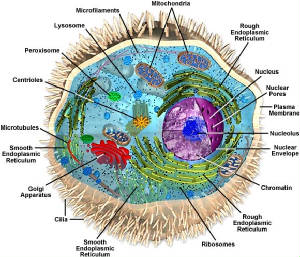
a.
Did you know cells are enclosed by a semi-permeable membrane???
Plasma Memebrane
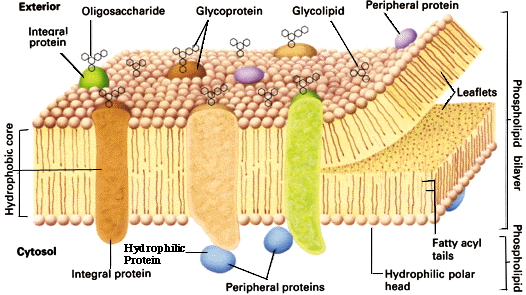
phospholipid bilayer

The cell is highly organized with many functional units or organelles. Most of these units are limited by one or more membranes.
To perform the function of the organelle, the membrane is specialized in that it contains specific proteins and lipid components
that enable it to perform its unique roles for that cell or organelle. In essence membranes are essential for the integrity
and function of the cell.
Membrane components may:
 be protective be protective
 regulate transport in and out of cell or subcellular domain regulate transport in and out of cell or subcellular domain
 allow selective receptivity and signal transduction by providing transmembrane receptors that bind signaling molecules allow selective receptivity and signal transduction by providing transmembrane receptors that bind signaling molecules
 allow cell recognition allow cell recognition
 provide anchoring sites for cytoskeletal filaments or components of the extracellular matrix. This allows the cell to maintain its shape and perhaps move to distant sites. provide anchoring sites for cytoskeletal filaments or components of the extracellular matrix. This allows the cell to maintain its shape and perhaps move to distant sites.
 help compartmentalize subcellular domains or microdomains help compartmentalize subcellular domains or microdomains
 provide a stable site for the binding and catalysis of enzymes. provide a stable site for the binding and catalysis of enzymes.
 regulate the fusion of the membrane with other membranes in the cell via specialized junctions ) regulate the fusion of the membrane with other membranes in the cell via specialized junctions )
 provide a passageway across the membrane for certain molecules, such as in gap junctions. provide a passageway across the membrane for certain molecules, such as in gap junctions.
 allow directed cell or organelle motility allow directed cell or organelle motility A cell is the smallest unit that can carry out life processes.They can
vary in size, shape and structure. A microscope is used for their study. Every cell has a selectively permeable cell
membrane. This means that some substances can pass through the cell membrane very easil, while some cannot. this is the permeability
of the cell membrane and semipermeable membranes just allow few substances to pass through them.these semipermiable membranes
regulate their interaction with their surroundings by letting few substances pass through them easily. by this activity the
cell membrane regulates the chemical composition of the cell. the semipermeable membranes are as a result of the chemical
and electrical properties of the membranes molecules. the example of the substance which can pass through them are lipid molecules,
such as alchohol, ether and chloroform. small molecules like water, glucose,amino acids, carbon dioxide and oxygen can also
pass through membranes ver easily. but large molecules like starch and proteins cannot. even in the same cell, the permeability
may vary from one moment to another.
A plasma membrane is the flexible boundry between the cell
and its environment. It allows a steady supply of nutrients such as amino acids, glucose adn lipids to come into the cell
no matter what the external conditions are. If a phosphate group replaces a fatty acid, a phospholipid is formed. It
has a glycerol backbone, two fatty acidchains and a phosphate group. The plasma memebrane is composed of a phospholipid bilayer,
which has two layers of phospholipids back-to-back.
diffusion: when a substance moves from an area of high concentration to an area
of low concentration.Active transport is the mediated transport of biochemicals, and other atomic/molecular substances, across membranes. Unlike passive transport, this process requires chemical energy. In this form of transport, molecules move against either an electrical or concentration gradient (collectively termed an electrochemical gradient). This is achieved by either altering the affinity of the binding site or altering the rate at
which the protein changes conformations.
Glucose, sodium ions and choride ions are just a few examples of molecules and ions that must efficently get across
the plasma membrane but to which the lipid bilayer of the membrane is virtually impermiable. Their transport must therefore
be "facilitated" by proteins that span the membrane and provide an alternative route or bypass. Facilitated diffusion
is the name given this process. It is similar to simple diffusion in the sense that it does not require expenditure of metabolic
energy and transport is again down an electrochemical gradient.
Two major groups of integral membrane proteins are involved in facilitated diffusion:
- Carrier proteins(also known as permeases or transporters) bind a specific type of solute and are thereby induced
to undergo a series of conformational changes which has the effect of carrying the solute to the other side of the membrane.
The carrier then discharges the solute and, through another conformational change, reorients in the membrane to its original
state. Typically, a given carrier will transport only a small group of related molecules.
Some important and illustrative
groups of transporters are:
- Certain of the hexose transporters, which transport glucose and similar monosaccharides into and out of cells
- Band 3, the anion transporter, which facilitates transport of bicarbonate and chloride ions
- Ion Channels do not really bind the solute, but are like hydrophilic pores through the membrane that open and allow
certain types of solutes, usually inorganic ions, to pass through. In general, channels are quite specific for the type of
solute they will transport and transport through channels is quite a bit faster than by carrier proteins. Additionally, many
channels contain a "gate" which is functions to control the channel's permiability. When the gate is open, the channel transports,
and when the gate is closed, the channel is closed. Such gates can be controlled either by voltage across the membrane (voltage-gated
channels) or have a binding site for a ligand which, when bound, causes the channels to open (ligand-gated channels).
Osmosis is the movement of water molecules from an area of
high concentration to an area of low concentration. Cell membranes are completely permeable to water, therefore, the environment
the cell is exposed to can have a dramatic effect on the cell. Hypertonic Solutions: contain
a high concentration of solute relative to another solution (e.g. the cell's cytoplasm). When a cell is placed in a
hypertonic solution, the water diffuses out of the cell, causing the cell to shrivel. Hypotonic Solutions:
contain a low concentration of solute relative to another solution (e.g. the cell's cytoplasm). When a cell is
placed in a hypotonic solution, the water diffuses into the cell, causing the cell to swell and possibly explode. Isotonic Solutions: contain the same concentration of solute as an another solution (e.g. the
cell's cytoplasm). When a cell is placed in an isotonic solution, the water diffuses into and out of the cell at the same
rate. The fluid that surrounds the body cells is isotonic.
The terms hypotonic and hypertonic are usually the big hang up. Both
these terms are opposite of each other. The prefix "hypo" means less than. What does a
hypotonic solution have less of? If you are thinking particles or solute, you are right!! Note that in
the middle diagram - the hypotonic solution surrounding the cell - there are fewer particles in the solution
surrounding the cell than in the cell (2 vs. 3). Since the parts of the solution (solute + solvent) must add up to 100%,
this means there is more water in the solution surrounding the cell than there is in the solution inside the cell!
A hypotonic solution contains fewer particles (less solute) but more water (the solvent) than the solution on the other
side of the membrane. Since water can move freely across cell membranes, it moves from an area where it is in greater
concentration to an area where the concentration is less. Thus, if a cell is placed in a hypotonic environment, water
will move into the cell (from an area of greater water concentration to an area of lesser water concentration). Note
the heavy arrows showing movement of water into the cell in the hypotonic solution - there is a net gain of water into the
cell.
Possibly the confusion lies in the fact that the term hypotonic refers to the particle concentration (hypo =
less than) whereas the process we are concerned with (water movement) is determined by the water concentration!
Isotonic solution: A solution that has the same salt concentration as the normal cells of the body and the blood. As opposed to a hypertonic solution or a hypotonic solution. An isotonic beverage may be drunk to replace the fluid and minerals which the body uses during physical activity.
C. What are eukaryotic cells?
There are two basic types of cells : Eukaryotic and prokaryotic. Eukaryotic cell are one type of cells which are
present in all living things except bacteria. Eukaryotic cells have many kinds of internal membrane-bound structures.
The most important of these in the nucleus, the structure in which the cells heriditary material (DNA) is located. The term,
"Eukaryotic" means "true nucleus". They are much more compartmentalized.
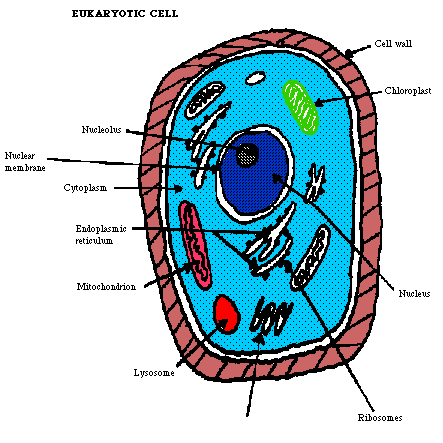
what are prokaryotic cells?
Prokaryotic cell lack internal membrane-bound structures. Within this type of cell, membranes do not seperate different
areas of the cell from each other. They make up the smallest single-celled organisms, bacteria. It means "without nucleus".
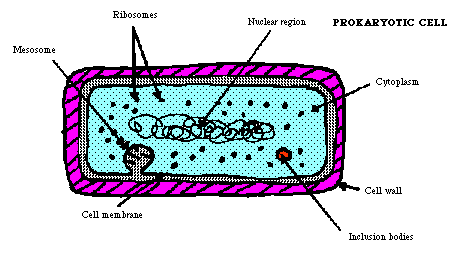
What are viruses?
Retrovirus
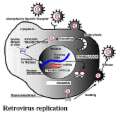
Virus

Viruses are tiny particles unlike any other living organisms.Infact ,scientist do not consider viruses to be living .They
are described as somewhere between living cells and non living things. Viruses lacks all other cell structures necessary
for metabolism , reproduction and growth.Viruses are much smaller than cells and were not actually seen until the
electron microscope was invented. Viruses vary in their structure and shape. Some are rod-shaped, such as Tobacco Mosaic Virus,
more commonly known as TMV. The herpes virus is polyhedral or many-sided. Still others may be helical, symmetry and icosahedral
symmetry .
|